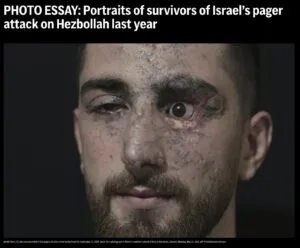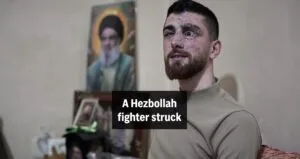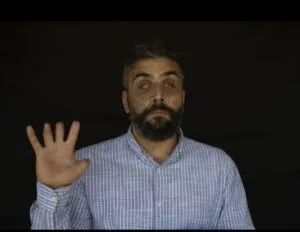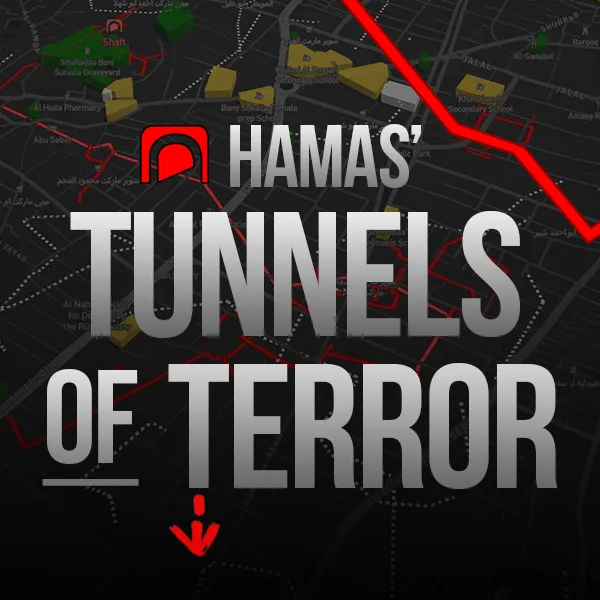There are moments in media criticism when the usual words – bias, omission, misleading framing – feel inadequate. Because this isn’t just about bias. It’s about a line crossed. It’s about a piece of so-called journalism so grotesque, so inverted in its moral compass, that it demands a different kind of response.
The Associated Press has published a photo essay titled, “Portraits of survivors of Israel’s pager attack on Hezbollah last year.” It features carefully staged portraits and sorrowful quotes – not just from Hezbollah operatives themselves, but also from a few of their relatives. Let’s not forget this is a U.S.- and EU-designated terror organization, and they were injured in a precision Israeli strike that neutralized dozens of Hezbollah fighters who were using encrypted pagers to coordinate attacks on Israeli civilians.
But AP doesn’t frame them as terrorists. It casts them as victims. As tragic figures. As men whose disfigured hands deserve your sympathy.
It is repulsive propaganda. Nothing more, nothing less.
We’re not going to walk you through what’s wrong with this piece. It’s too obvious. The entire thing is a distortion. Every image, every quote, every omission – from the total lack of context about Hezbollah’s crimes, including the fact that these very pagers were used to orchestrate lethal attacks on Israelis, to the aesthetic choices that frame mutilated killers in dramatic, reverent lighting – is an insult.
An insult to the thousands of Israelis murdered or maimed by Hezbollah. To the innocent Lebanese civilians crushed under its rule. And to the readers themselves, because how many millions around the world have been directly or indirectly torn apart by Islamist terrorism?


The Aestheticization of Terror
The portraits are the first clue. Each fighter, or relative of a fighter, is photographed against a pitch-black background, lit just enough to highlight scars, stumps, and furrowed brows. Their eyes are cast downward or off into the middle distance. They are composed. Thoughtful. Vulnerable.
There is no blood. No chaos. No evidence of what came before. Just the frozen dignity of men, women, and teenagers supposedly broken by war.
This is not journalism. It is image-crafting. And it works.

The disfigured Hezbollah operatives appear mythic, stoic, tragic. Not for what they’ve done, but for what’s been done to them. The visual language here is not accidental. It mimics portraiture used for cancer survivors, injured veterans, and victims of domestic violence. The kind of images that demand empathy and suspend judgment.
Now contrast that with how Israeli victims of Hezbollah are typically shown in Western media, if they’re shown at all. Blurry photos from attack scenes. Names barely mentioned. Faces rarely shown.
But AP found the time, the resources, and the artistic vision to give Hezbollah fighters a studio-style shoot and a global platform. The goal was simple: to soften their image, obscure their crimes, and make you forget who they are – so you remember only how they look now.
.@AP looked at terrorists who helped murder Israelis and thought:
“Let’s interview their mothers.”
No mention of the victims. No mention of the terror.
Just tears for Hezbollah.
This is how you sanitize evil. pic.twitter.com/t1GbrxXbCR— HonestReporting (@HonestReporting) August 6, 2025
The Inversion of Victim and Aggressor
One of the men featured, Mahdi Sheri, 23, a Hezbollah member, laments that he can no longer return to his former job on the front line. “Now,” the AP reports with near admiration, “Hezbollah is helping him find a new job.”
Other captions allude to trauma and paint a picture of resilience. Even the children of terrorists, AP notes, “now fear coming near their fathers.” As if the real tragedy isn’t the terror their fathers unleashed – but the fact that their children are afraid of their monstrous parents.
Not once does the AP mention what these men were doing before they were injured: actively working to kill Israelis.
These were not bystanders caught in crossfire. These were operatives of an Iranian-backed terror group, engaged in covert operations using encrypted pagers, the same technology Hezbollah has used for decades to coordinate rocket fire and ambushes targeting civilians.
But instead of reporting that fact, AP chose to wrap them in tragedy and give them the space to monologue about their pain.
So allow us to do the job they wouldn’t.
The Real Victims: Murdered by Hezbollah
-
241 U.S. Marines and 58 French paratroopers, serving in a multinational peacekeeping force, murdered in the Beirut barracks bombing in 1983.
-
114 people killed in the Israeli Embassy bombing (1992) and the AMIA Jewish Center bombing (1994) in Buenos Aires.
-
19 U.S. Air Force personnel murdered in the Khobar Towers bombing in Saudi Arabia in 1996.
-
Eight Israeli soldiers murdered in a cross-border raid, with two others taken hostage and later killed — the attack that triggered the 2006 Lebanon War, during which 43 Israeli civilians and 121 IDF soldiers were killed by Hezbollah rocket fire.
-
Dozens of Israeli civilians and security personnel killed in Hezbollah attacks during the 2023–2024 Israel–Hezbollah conflict, launched after the October 7 Hamas massacre.
Over 60,000 Israeli residents of the north were displaced.
In July 2024, a Hezbollah rocket struck a soccer field in Majdal Shams, killing at least 12 children.
This is not a full list.
The media finds its focus when photographing the wounded bodies of terrorists.
But it falls silent when it comes to their victims.
Call It What It Is
This isn’t journalism. It’s image laundering – the glorification of terror, repackaged as human interest.
And it’s not new.
We’ve seen it before: when The New York Times ran glowing features on Hamas-linked “journalists,” when the BBC called Qassam Brigade commanders “fighters,” and when Reuters gave Islamic Jihad operatives a platform without ever asking why they fire rockets at Israeli kindergartens.
It’s the same playbook:
Humanize the perpetrator.
Aestheticize the violence.
Erase the victims.
Call it balance.
But this isn’t balance.
It’s complicity.
The Associated Press didn’t just publish a photo essay.
It published a shrine.
Liked this article? Follow HonestReporting on Twitter, Facebook, Instagram and TikTok to see even more posts and videos debunking news bias and smears, as well as other content explaining what’s really going on in Israel and the region. Get updates direct to your phone. Join our WhatsApp and Telegram channels!


